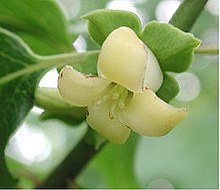Persimmon
| Persimmon | |
|---|---|
 |
|
| Persimmon flower | |
| Scientific classification | |
| Kingdom: | Plantae |
| (unranked): | Angiosperms |
| (unranked): | Eudicots |
| (unranked): | Asterids |
| Order: | Ericales |
| Family: | Ebenaceae |
| Genus: | Diospyros |
| Species | |
|
See text |
|
| Nutritional value per 100 g (3.5 oz) | |
|---|---|
| Energy | 293 kJ (70 kcal) |
|
18.59 g
|
|
| Sugars | 12.53 g |
| Dietary fiber | 3.6 g |
|
0.19 g
|
|
|
0.58 g
|
|
| Vitamins | |
| Vitamin A equiv. |
(10%)
81 μg
(2%)
253 μg834 μg
|
| Thiamine (B1) |
(3%)
0.03 mg |
| Riboflavin (B2) |
(2%)
0.02 mg |
| Niacin (B3) |
(1%)
0.1 mg |
| Vitamin B6 |
(8%)
0.1 mg |
| Folate (B9) |
(2%)
8 μg |
| Choline |
(2%)
7.6 mg |
| Vitamin C |
(9%)
7.5 mg |
| Vitamin E |
(5%)
0.73 mg |
| Vitamin K |
(2%)
2.6 μg |
| Minerals | |
| Calcium |
(1%)
8 mg |
| Iron |
(1%)
0.15 mg |
| Magnesium |
(3%)
9 mg |
| Manganese |
(17%)
0.355 mg |
| Phosphorus |
(2%)
17 mg |
| Potassium |
(3%)
161 mg |
| Sodium |
(0%)
1 mg |
| Zinc |
(1%)
0.11 mg |
|
|
|
|
|
| Percentages are roughly approximated using US recommendations for adults. Source: USDA Nutrient Database |
|
| Nutritional value per 100 g (3.5 oz) | |
|---|---|
| Energy | 531 kJ (127 kcal) |
|
33.5 g
|
|
| Sugars | n/a |
| Dietary fiber | n/a |
|
0.4 g
|
|
|
0.8 g
|
|
| Vitamins | |
| Vitamin C |
(80%)
66 mg |
| Minerals | |
| Calcium |
(3%)
27 mg |
| Iron |
(19%)
2.5 mg |
| Phosphorus |
(4%)
26 mg |
| Potassium |
(7%)
310 mg |
| Sodium |
(0%)
1 mg |
|
|
|
|
|
| Percentages are roughly approximated using US recommendations for adults. Source: USDA Nutrient Database |
|
See text
The persimmon /pərˈsɪmən/ (sometimes spelled persimon) is the edible fruit of a number of species of trees in the genus Diospyros. Diospyros is in the family Ebenaceae, and other members of the genus are grown for ebony timber. The most widely cultivated species is the Oriental or Japanese persimmon, Diospyros kaki. In color, the ripe fruit of the cultivated strains range from light yellow-orange to dark red-orange depending on the species and variety. They similarly vary in size from 1.5 to 9 cm (0.59 to 3.54 in) in diameter, and in shape the varieties may be spherical, acorn-, or pumpkin-shaped. The calyx generally remains attached to the fruit after harvesting, but becomes easy to remove once the fruit is ripe. The ripe fruit has a high glucose content. The protein content is low, but it has a balanced protein profile. Persimmon fruits have been put to various medicinal and chemical uses.
Like the tomato, persimmons are not popularly considered to be berries, but in terms of botanical morphology, the fruit is in fact a berry.
The word Diospyros comes from the ancient Greek words "dios" (δῐος) and "pyron" (πῡρον). A popular etymology construed this as "divine fruit", or as meaning "wheat of Zeus" or "God's pear" and "Jove's fire". The dio-, as shown by the short vowel 'i' has nothing to do with 'divine' (δῑoς ), dio- being an affix attached to plant names, and in classical Greek the compound referred to 'the fruit of the nettle tree'. The Modern Greek name for the fruit is λωτός (lotos), which leads modern Greeks to the assumption that this is the lotus referred to in Homer's Odyssey.
...
Wikipedia
